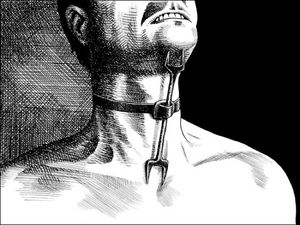Heretic's fork: Difference between revisions
(Created page with "{{Header}} right|thumb The '''Heretic's Fork''' was a torture device, loosely consisting of a length of metal with two opposed bi-pronged "forks"...") |
No edit summary |
||
| Line 2: | Line 2: | ||
[[Image:Heretics fork.jpg|right|thumb]] | [[Image:Heretics fork.jpg|right|thumb]] | ||
The '''Heretic's Fork''' was a torture device, loosely consisting of a length of metal with two opposed bi-pronged "forks" as well as an attached belt or strap. | The '''Heretic's Fork''' was a torture device, loosely consisting of a length of metal with two opposed bi-pronged "forks" as well as an attached belt or strap. This made the prongs press against his chin and sternum; he was forced to hold his head back and motionless to avoid having the prongs pierce him; after a while, this caused agonizing cramps in his neck. He would probably have had difficulty speaking. | ||
The device was attributed to the Spanish Inquisition and was designed to make a suspected heretic confess. | |||
One end was pushed under the chin and the other into the sternum, the strap fixing the device to the neck. This effectively immobilized the head at a total extension of the neck and caused great pain. | |||
Traditionally, the fork was engraved with the [[Latin]] word "<I>abiuro</I>" (meaning "I recant"), | |||
{{Torture}}{{footer}} | {{Torture}}{{footer}} | ||
Latest revision as of 06:03, 4 April 2022
The Heretic's Fork was a torture device, loosely consisting of a length of metal with two opposed bi-pronged "forks" as well as an attached belt or strap. This made the prongs press against his chin and sternum; he was forced to hold his head back and motionless to avoid having the prongs pierce him; after a while, this caused agonizing cramps in his neck. He would probably have had difficulty speaking.
The device was attributed to the Spanish Inquisition and was designed to make a suspected heretic confess.
One end was pushed under the chin and the other into the sternum, the strap fixing the device to the neck. This effectively immobilized the head at a total extension of the neck and caused great pain.
Traditionally, the fork was engraved with the Latin word "abiuro" (meaning "I recant"),
Chat rooms • What links here • Copyright info • Contact information • Category:Root
